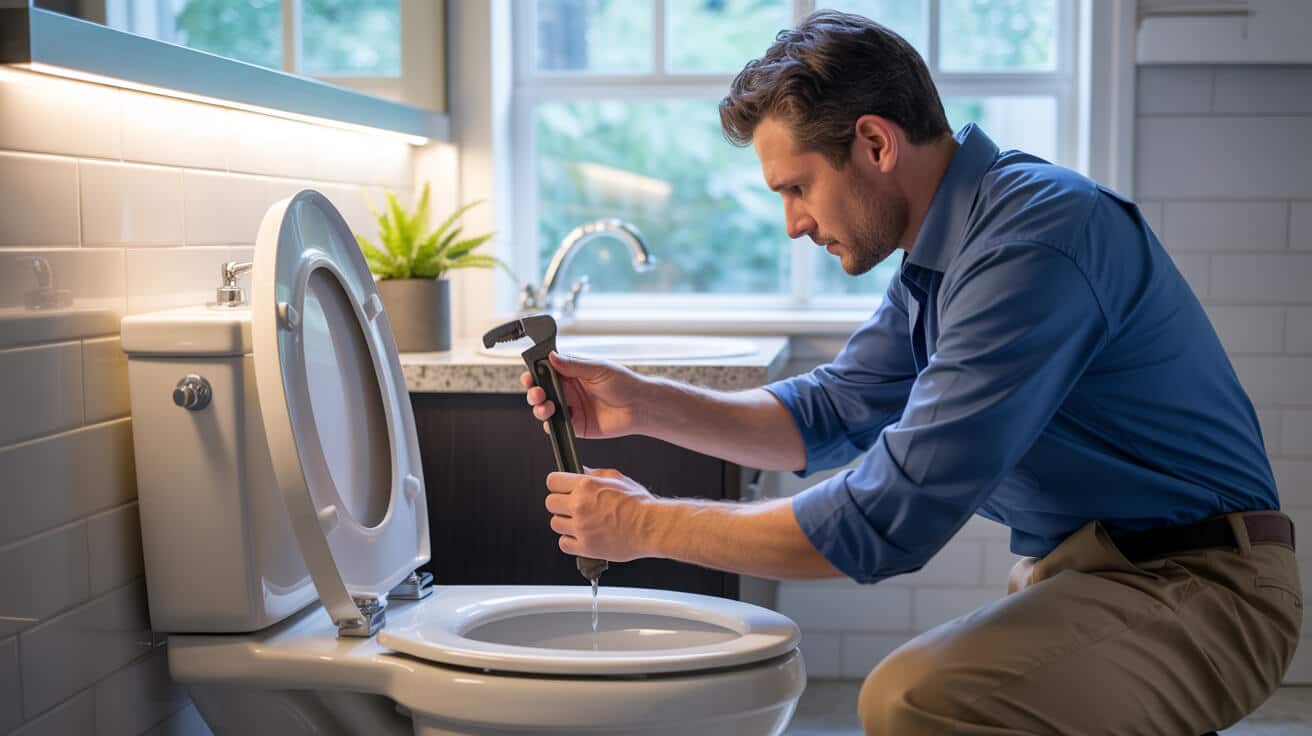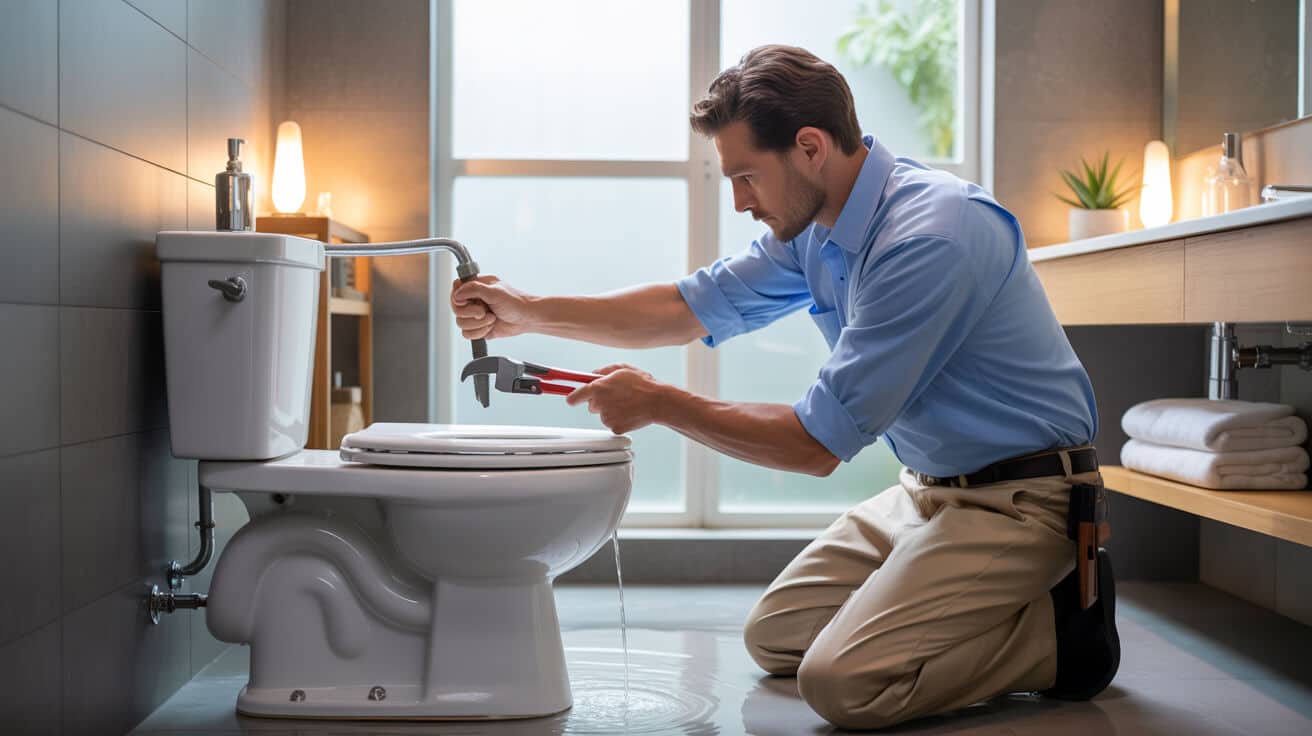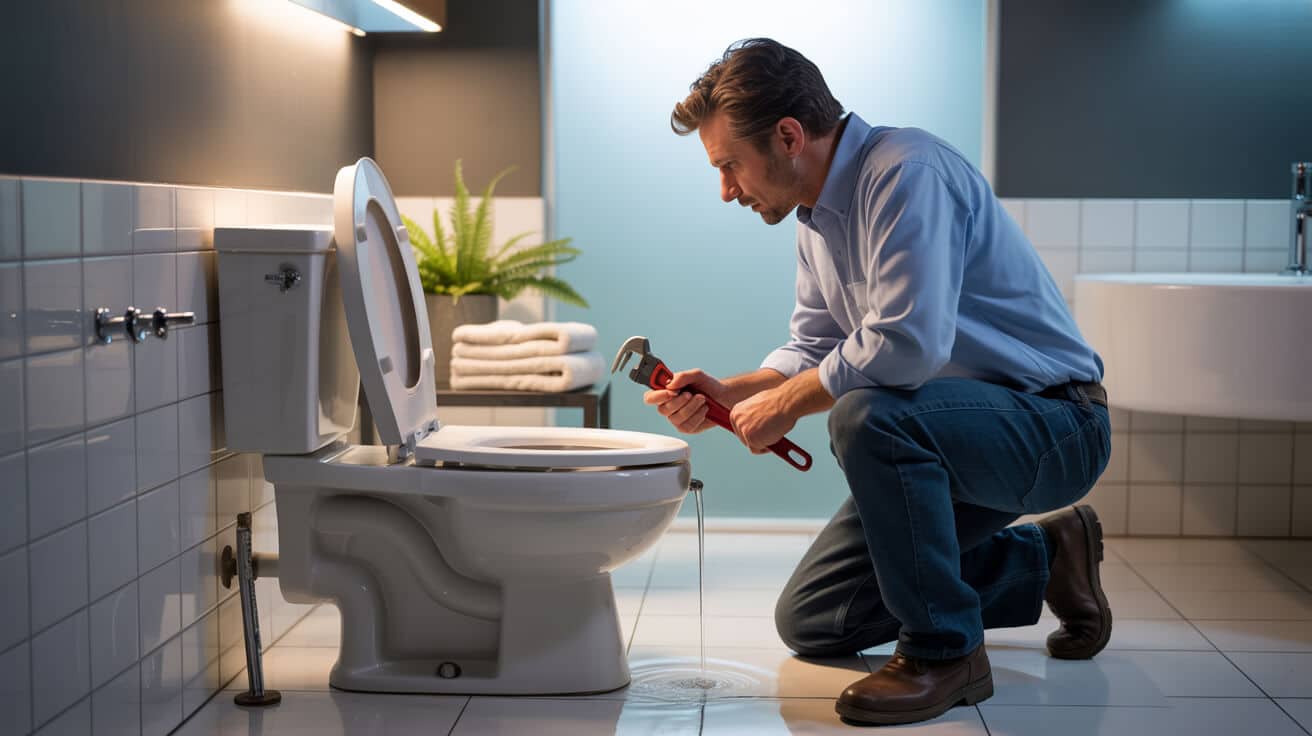Systems affected by continuous leakage risk not only financial and environmental waste, but further harm through moisture damage, increased wear on connected plumbing, and potential exposure to regulatory penalties—especially where building codes or lease obligations hold property owners accountable for timely repair. Participating in the lifecycle of building care, repair of this fault intersects personal diligence, legal obligation, and the operational reliability delivered by professional Plumbing & Heating Companies such as Plumbers 4U.
Running toilets present as persistent audible refilling, visible trickles, or observed water movement at the pan—symptoms easily underestimated yet capable of generating substantial ongoing losses. Estimates place the unnoticed leak of a single modern cistern at hundreds of litres per day, overshadowing nearly all other routine domestic water waste, while amplifying your utility costs and, in some circumstances, threatening property insurance terms or regulatory standing.
While the perceived simplicity of toilet mechanics often invites do-it-yourself intervention, persistent faults typically require careful differential diagnosis, component compatibility checks, and documentation for rental agreements or regulatory inspection. Professional services, including those provided by Plumbers 4U, approach these repairs not only as technical corrections but as critical moments of asset preservation, compliance alignment, and tenant or occupant reassurance—a position amplified in multi-unit, commercial, or high-usage building contexts.
Etymology or name origin
The phrase “running toilet”—in use since the early twentieth century—originates from the symptom of uninterrupted water movement, a term shared with the alternate “leaking cistern” or “continuous flow WC” common to British engineering documents and professional plumbing discourse. The term captures both a descriptive and aesthetic concern: what is “running” is not just the water, but the metre, the bill, and, over time, the patience of occupants or property managers. Industry codes, customer communications, and regulatory guidance likewise invoke these terms to standardise reporting, asset documentation, and corrective protocols across geographical contexts.
Overview / context
Toilets are foundational technologies in modern plumbing, their basic principle unchanged: deliver a measured quantity of water to remove waste and create a sanitary barrier. In the typical gravity-operated or pressure-aided system, a cistern stores water above the pan, releasing it via an actuated valve; a float-controlled inlet valve refills the tank and halts automatically at a preset level.
Within the property management sphere, a running cistern disrupts this equilibrium, whether from aged gaskets, sediment accumulation, valve fatigue, improper installation, or even overexuberant cleaning products that damage sensitive rubbers or plastics. The issue escalates in scale within rental and commercial settings—where a single unseen leak, multiplied over many fixtures, can lead to dramatic water losses, costs, and regulatory intervention.
Asset logs from facility management companies increasingly chart running toilets as leading edge-case triggers for emergency repair, regulatory inspection, insurance claim, or tenant dispute. For facilities managers and landlords, the urgency of response is underlined by legislation and, often, by reputational or contractual obligations to maintain sanitary, water-efficient premises.
History
Origins
Water closets first emerged in the late seventeenth century, with the 1775 patent of Alexander Cumming’s S-trap bringing reliable sewer separation and an end to unsightly odours. Early systems leveraged simple pull-chain actuators and cisterns with hard-wearing, if imprecise, flush valves—resulting in frequent incomplete closures and regular “running” complaints.
Industrial emergence
The expansion of city living and the spread of water infrastructure in the nineteenth and twentieth centuries drove the evolution of standardised float valves, mass-produced brassware, and increasingly robust yet affordable cistern assemblies. Handbook literature of the era details both the symptoms and standard-of-service responses for persistent overflows and leaks, positioning routine inspection and valve tune-up as essential duties for domestic staff and early plumbers alike.
Contemporary evolution
Progression to plastics, dual-flush actuators (to conserve water), and hidden cisterns in modern bathrooms introduced both advances and new vulnerabilities: proprietary part shapes, multiple actuator pathways, and tighter tolerances mean that repair tasks increasingly require specific technical knowledge and access to branded or compliant spares. Regulatory reforms in the late twentieth and early twenty-first century (notably the Water Supply (Water Fittings) Regulations 1999) codified proactive maintenance duties for building owners and compelled companies such as Plumbers 4U to specialise in compliant, documented diagnosis and repair of running cisterns as a routine asset management task.

Concept / description
Flush toilets operate as an integrated system of tank, bowl, valves, lever or button actuators, and seals. During flushing, a user-initiated mechanism (handle, button) lifts or actuates a flush valve, releasing water with gravity or pressurised assistance. Following complete drainage, the fill valve reopens, admitting water and closing under float control when reaching the required level. Auxiliary structures—including overflow tubes, isolation valves, and cistern air gaps—protect against uncontrolled filling.
Problems arise when one or more elements fails to fully close or maintain separation, breaking the tank-to-bowl seal, or when debris blocks proper valve functioning. Failure may result from calcification, rubber hardening, improper part selection, misaligned linkage, or incorrect installation depths.
Components diagram
| Component | Function | Failure Risk |
|---|---|---|
| Flush valve | Releases stored water to bowl | Seal leaks, misalign |
| Fill valve | Refills cistern post-flush | Constant fill, stuck |
| Flapper/gasket | Seals flush valve base | Aged, warped |
| Float/float cup | Regulates fill shut-off | Sticking, wrong set |
| Chain/linkage | Connects actuator to valve | Disconnection, slack |
| Overflow tube | Prevents high fills from flooding | Set too high/low |
| Isolation valve | Permits repair without system shutdown | Blocked, stuck |
Functionality / purpose / applications
Toilet installations serve to efficiently remove waste while minimising water use and preventing odours. Properly functioning flush systems ensure rapid, complete evacuation with a single, controlled actuation and block any uncontrolled water movement between flushes.
Running toilets betray a breakdown in this ideal, as continuous or intermittent flow not only undermines hygiene and increases water demand but can mask underlying issues with supply pressure, installation error, or material decay. In larger properties or managed portfolios, delayed repair accelerates operating expenditure, regulatory exposure, and can spark legal disputes with tenants or authorities, who may experience property damp, increased bills, or loss of sanitary certification.
In multi-unit environments such as hotels, schools, or housing associations, the fault profile of a running toilet advances from an inconvenience to a major operational and reputational risk. Plumbers 4U and equivalent firms structure their asset management, response processes, and aftercare programmes to address these distinct use-cases through routine inspections, proactive reporting, and rapid, standards-compliant intervention.
Classifications / types / variants
Traditional assemblies
Most pre-millennium installations feature lever-actuated cisterns with simple float-arm fill valves, rubber or silicone flapper/washer seals, and manually adjustable components. These configurations, although robust, are susceptible to seal fatigue, pilot hole enlargement, and float or arm mechanical failure.
Dual-flush systems
Designed for water conservation, dual-flush toilets implement two-stage actuators and often proprietary flush/tank geometries. The technical advantage of reduced per-use water comes at the cost of more complex internals—multiple seals, pneumatic or cable-linked buttons, and flow diverters—each an additional source of potential leakage.
Concealed or bespoke cisterns
Wall-hung or under-counter installations hide the tank behind tile or panel, with access via small removable hatches or panels. Repairs demand specialist knowledge, niche tools, and careful part sourcing, as but one improper fitment risks repeated faults or cosmetic damage.
Table: Actuator/fill valve comparison
| Type | Activation | Repair Complexity | Reliability Notes |
|---|---|---|---|
| Lever | Mechanical | Low | Simple, easily replaced |
| Push button | Mechanical | Moderate | Varies by model |
| Sensor | Electronic | High (specialist) | Requires battery/power, rare |
| Float arm | Mechanical | Low | Familiar failure profile |
| Float cup | Mechanical | Low–Medium | Compact, sensitive to scale |
Systems / tools / methodologies
Tools and materials
To repair modern and legacy cisterns, practitioners rely on a blend of specialised and general-purpose tools:
- Adjustable spanner or wrench
- Flat- and cross-head screwdrivers
- Valve-specific sockets
- Leak detection dye (for silent leaks)
- Allen keys or proprietary tools for certain actuators
- Clean, WRAS-approved replacement valves and gaskets
- Towels and water-catching materials for minimising spill
Diagnosis steps
- Visual inspection: Open the cistern and examine all joints, valve seats, and actuation linkages.
- Auditory cues: Listen for running water, whistling, or hissing from fill or flush valves.
- Dye test: Introduce dye to the cistern; observe colour in the bowl to confirm silent leaks.
- Isolation: Close the system at the isolation valve and observe any change; persistent running may indicate multi-path failure.
Service company protocol
Experienced service providers such as Plumbers 4U orchestrate call-out, quote, and repair cycles with transparency. You can expect
- Pre-arrival notifications and booking confirmation for appointment certainty.
- On-site diagnostic and repair with full part traceability.
- Documentation: receipt, photo log, and compliance certificate where necessary.
- Aftercare advice and asset log entry, important for ongoing facility management and regulatory inspection.

Stakeholders / entities involved
Homeowners
As decision-makers and primary asset stewards, you are typically responsible for leak identification and repair, both to protect your property value and to ensure compliance with local water regulations.
Tenants and occupiers
You are typically expected to report persistent leaks per lease or occupancy agreement; delayed notice can sometimes shift responsibility or liability as defined in rental or managed property contracts.
Landlords and property managers
You bear a legal and operational duty to maintain plumbing in good repair; running toilets are a frequent trigger of tenant complaint or regulatory investigation. Reliable recordkeeping, evidence of timely repair, and use of certified services such as Plumbers 4U reduce legal and financial risk.
Facilities managers and organisations
For commercial and publicly accessible buildings, your asset registers, maintenance schedules, and regulatory logs should explicitly track all water loss events from WCs and related systems; insurance, operations, and compliance audits often reference these data.
Service providers
Fully licenced engineers and company staff are accountable for correct identification and rectification; apprentices are increasingly trained on advanced valve designs and evolving compliance requirements, with job outcomes documented in alignment with national or regional codes of practice.
Legal / regulatory / ethical considerations
Legal duties
United Kingdom Water Supply (Water Fittings) Regulations 1999, Building Regulations (Part G), and similar codes in other jurisdictions mandate leak prevention, minimum repair standards, and, for some installations, maximum refill volumes and time-to-repair. Landlords face “fit for habitation” and prompt repair mandates under tenant law.
Product and installation mandates
All replacement components must carry the appropriate WRAS approval (or equivalent) to ensure compatibility and adherence to standards. Non-compliance can result in refusal of insurance payments, fines, or demand for rework after audit. Service companies provide part/document tracking to simplify these requirements.
Asset, compliance, and recordkeeping
Professional service often demands part codes, engineer record, and photo evidence for property management systems. These logs fortify you or your company in dispute resolution, property transfer, or insurance and regulatory events.
Ethical responsibility
Delay or neglect of running toilet repairs contributes to regional water scarcity, environmental loading, unnecessary costs, and, occasionally, hazards from mould or concealed moisture. Plumbers 4U prioritises transparency and eco-conscious repair standard as a core aspect of our service identity.
Performance metrics / data / measurements
| Parameter | Normal Range | Fault Condition |
|---|---|---|
| Complete refill | 1–3 minutes | >3 minutes or never completes |
| Water used per cycle | 5–9 litres (dual less) | Up to 500–1000+ litres/day wasted |
| Decibel level | <40 dB at rest | Audible hiss trickle/run |
| Visual cues | No movement at rest | Trickling water in pan, tank drop |
- Financial impact: A single running unit can add hundreds in annual water billing. In large portfolios or multi-occupancy, aggregated costs regularly run into the thousands—particularly high for regions dependent on utility metering.
- Operational impact: Repair documentation, scheduling, and asset logs serve both compliance and long-term property management functions; records maintained by Plumbers 4U prove critical to successful audits or claims.
Challenges / barriers / limitations
Professional and do-it-yourself repairs alike confront practical and systemic challenges:
- Access limitations: Concealed units or restricted space installations increase both time and labour required, sometimes necessitating partial demolition or custom parts.
- Part variability: Proprietary, outdated, or manufacturer-specific components may be difficult to source or match.
- Knowledge gaps: Many tenants and even experienced caretakers may overlook “silent” leaks, leading to extended water loss or secondary damage.
- Regulatory inertia: Local variations in code or inspection practices may delay full harmonisation of standards, especially for legacy systems.
- Environmental costs: Every unrepaired running cistern undermines both community and water utility efforts to reduce waste, conserve resources, and limit environmental damage.
Impact / influence / legacy
Continuous improvement in flush and valve design, the diffusion of periodic inspection and documented repair, and the professionalisation of Plumbing & Heating services have together made running toilets less impactful than in previous generations. Nevertheless, the issue persists in both the physical and symbolic record of household, rental, and commercial management.
- Water stewardship: Prompt repair reduces wastage, supports conservation objectives, and displays responsible management in both private and commercial settings.
- Property value: Regular inspection and efficient recordkeeping support higher values and attract higher-quality tenants.
- Certification: Professionally repaired and documented assets bolster your compliance position and simplify property sales, insurance, or regulatory event resolution.
- Tenant loyalties and satisfaction: Quick, well-managed repairs support longer stays, fewer disputes, and positive online/social reputation for both companies and individuals.
Future directions, cultural relevance, and design discourse
The future of running toilet repair is shaped by evolving expectations at every scale: smarter materials offer longer part life, integrated diagnostics indicate leaks earlier, and regulatory pressure drives ever-faster repair cycles and traceability. Facilities and housing providers increasingly rely on companies who combine technical skill, rigorous documentation, and environmental sensibility.
Emerging building codes, including proposed revisions to water management in both the UK and other regions, continue to lower the threshold for what constitutes “acceptable loss”, pushing landlords, asset managers, and homeowners to monitor, report, and act with unprecedented transparency. The “silent leak” persists as a test of ethics and stewardship—your response is no longer optional, but a reflection of how seriously you value your property, your tenants, and your obligations to the built environment.

